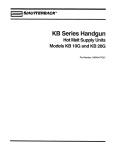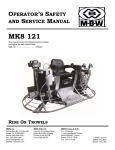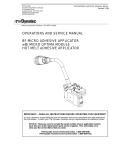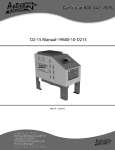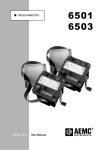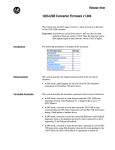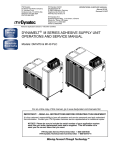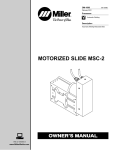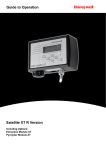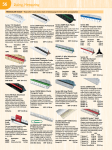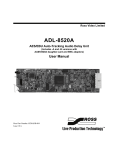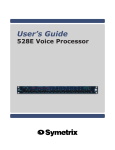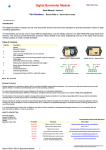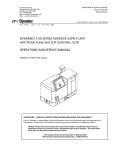Download warning - Astro Packaging, Inc.
Transcript
SAFETY PRECAUTIONS GENERAL CONSIDERATIONS SERVICING EQUIPMENT 1. Read and follow these instructions. Failure to do this could result in severe personal injury or death. 1. Only trained personnel are to operate and service equipment. 2. Additional safety instructions and/or symbols are located throughout this manual. They serve to warn maintenance personnel and operators about potentially hazardous situations. 2. Never service equipment while it is in motion. 3. Inspect the machine for unsafe conditions daily and replace all worn or defective parts. 3. Shut off the equipment and lock out all input power and air supply at their sources before attempting any maintenance. 4. Follow the maintenance and service instructions in the manual. 4. Keep work area uncluttered and well lit. SIGNS 5. All covers and guards must be in place before operating this equipment. For precautions and definitions of safety symbols, refer to Safety Chapter of the service manual. 1. Read and obey all of the warning labels, signs and caution statements on the equipment. 2. Do not remove or deface any of the warning labels, signs, and caution statements on the equipment. 3. Replace any warning labels, signs, and caution statements which have been removed or defaced. Replacements are available. ADDITIONAL CONSIDERATIONS 1. To ensure proper operation of the equipment, use specified electrical and/or air supply sources. 2. Do not attempt to alter the design of the equipment unless written approval is received from our factory. 3. Keep all manuals readily accessible at all times and refer to it often for the best performance from your equipment. TABLE OF CONTENTS Chapter 1 Safety Precautions Chapter - Page # Chapter 2 Description & Specifications Description ............................................................................................................................................ 2-1 Specifications ........................................................................................................................................ 2 - 2 Dimensions ............................................................................................................................................ 2 - 3 Chapter 3 Installation & Start Up Mounting & Lifting ASU .................................................................................................................... 3-1 Installation ............................................................................................................................................. 3-2 Adding Adhesive ................................................................................................................................. 3-3 Changing Adhesive Formula ........................................................................................................... 3 - 3 Wattage Availability Chart ............................................................................................................... 3-4 Typical Start Up & Shut Down Procedures ................................................................................. 3-4 Storage & Disposal of the Application System ......................................................................... 3-5 Chapter 4 Temperature Controller Set-Up Temperature Control Functions in General ............................................................................... 4-1 Defining Temperature Control Terms .......................................................................................... 4 - 1 Error Indication Message .................................................................................................................. 4-2 Firmware Chip & Checksum ............................................................................................................ 4-3 System Values ....................................................................................................................................... 4-3 Helpful Hints ......................................................................................................................................... 4-4 Chapter 5 Programming of the Controller Controller Keypad ............................................................................................................................... 5-1 Programming ........................................................................................................................................ 5 - 2 Service Functions ................................................................................................................................ 5-4 Controller Features ............................................................................................................................. 5-9 Optional Features ................................................................................................................................ 5 - 10 ©Astro Packaging AP50 Manual-19600-09-AP50 Chapter 6 Preventive Maintenance General Cleaning ................................................................................................................................. 6-1 Purging Manifold of Adhesive and Pressure ............................................................................. 6-1 Output Filter .......................................................................................................................................... 6 - 2 Hose Fittings and Fasteners ............................................................................................................. 6 - 3 Tank Screen Cleaning ......................................................................................................................... 6 - 3 Summary of Preventative Maintenance ..................................................................................... 6-4 Chapter 7 Troubleshooting General Troubleshooting .................................................................................................................. 7 - 1 Handling Printed Circuit Boards .................................................................................................... 7-1 Control Printed Circuit Boards ........................................................................................................ 7-2 Over-temp Thermostat ...................................................................................................................... 7 - 3 Tank Over-current ............................................................................................................................... 7-3 Ready Contact to Parent Machine ................................................................................................. 7 - 3 Temperature Zones Not Heating ................................................................................................... 7-3 Location of PCB, Circuit Breaker, Over-temp Thermostat Re-set & RTD Sensor ............ 7 - 2 Resistance Tables ................................................................................................................................. 7-4 Troubleshooting Guide ..................................................................................................................... 7-5 Piston Pump Troubleshooting Guide ........................................................................................... 7-9 Chapter 8 Disassembly & Re-assembly Procedures To Access Electrical Parts .................................................................................................................. 8-1 Printed Circuit Board Replacement .............................................................................................. 8-2 Re-assembly Procedures & Cautions ............................................................................................ 8-3 Chapter 9 Component Illustrations & Bills of Material Pumps, V2 & Accessories .................................................................................................................. 9-2 Standard Fan-Cooled Motors .......................................................................................................... 9-3 ©Astro Packaging AP50 Manual-19600-09-AP50 Chapter 10 Component Illustrations Hose Schematic: all models ............................................................................................................. 10 - 1 Head Schematic: all models ............................................................................................................ 10 - 2 Wiring Diagram 10 - 3 ©Astro Packaging AP50 Manual-19600-09-AP50 Chapter 1 SAFETY PRECAUTIONS All operators and service personnel must read and understand this manual before servicing equipment. All maintenance and service on this equipment must be performed by trained technicians. Electrical DANGER HIGH VOLTAGE Dangerous voltages exist at several points in this equipment. To avoid personal injury, do not touch exposed connections and components while input power is on. Disconnect, lockout and tag external electrical power before removing protective panels. A secure connection to a reliable earth ground is essential for safe operation. A disconnection switch with lockout capability must be provided in the line ahead of the unit. Wiring used to supply electrical power should be installed by a qualified electrician. High Temperatures WARNING HOT SURFACE Severe burns can occur if unprotected skin comes in contact with molten adhesive or hot application system parts. Safety glasses, gloves, and long-sleeved clothing must be worn whenever working with or around adhesive application systems. High Pressure WARNING HIGH PRESSURE PRESSURE To avoid personal injury, do not operate the equipment without all covers, panels, and safety guards properly installed. To prevent serious injury from molten adhesive under pressure when servicing the equipment, disengage the pumps and relieve the adhesive under pressure (e.g. trigger the heads, hand-held applicators, and/or other application devices into a waste container) before opening any hydraulic fittings can connections. Protective Covers Keep all guards in place! WARNING DO NOT OPERATE WITHOUT GUARDS IN PLACE ©Astro Packaging To avoid personal injury, do not operate the application system without all covers, panels, and safety guards properly installed. AP50 Manual-19600-09-AP50 1-1 Eye Protection & Protective Clothing WARNING It is very important that you PROTECT YOUR EYES when working around hot melt adhesive equipment ! EYE PROTECTION REQUIRED Wear glasses with side shields which conform to ANSI Z87.1 or EN166 Failure to wear safety glasses could result in severe eye injury. PROTECTIVE CLOTHING REQUIRED It is important to protect yourself from potential burns when working around hot melt adhesive equipment. Always wear steel reinforced safety shoes. Wear protective gloves and long-sleeved, protective clothing to prevent burns that could result from contact with hot material or hot components. _________________________________________________________________________________________ Safe Installation and Operation To avoid possible failure of hoses, make sure all hoses are routed to avoid kinking, tight radius turns (8” or less) and abrasive contact. Hot-melt hoses should not have prolonged contact with heat-absorbing surfaces such as cold floors or metal troughs. These heat-absorbing surfaces can alter adhesive flow and cause incorrect calibration. Hoses should never be covered with materials that precent heat dissipation, such as insulation or sheathing. Read this manual before applying electrical power to the equipment. Equipment may be damaged by incorrect electrical connections. Do not use adhesive that is dirty or that may be chemically contaminated. Doing so can cause system clogging and pump damage. When adhesive hand-help applicators or other movable applicators are used, never point them a yourself or at any other person. Never leave a hand-held applicator’s in use. Do not operate the tank or other system components without adhesive for more than 15 minutes if the temperature is 150 degrees C (300 degrees F) or more. To do so will cause charring of the residual adhesive. Never activate the heads, hand-held applicators and/or other application devices until adhesive’s temperature is within the operating range. Severe damage could result to internal parts and seals. _________________________________________________________________________________________ Treatment for Burns From Hot Melt Adhesives Burns caused by hot melt adhesives must be treated at a burn center. ©Astro Packaging AP50 Manual-19600-09-AP50 1-2 Care should be used when working with hot melt adhesives in the molten state. Because they rapidly solidify, they present a unique hazards. Even when first solidified, they are still hot and can cause severe burns. When working near a hot melt application system, always wear safety gloves, safety glasses and long-sleeved, protective clothing. Always have first-aid information and supplies available. Call physician and/or an emergency medical technician immediately. _________________________________________________________________________________________ Service Refer all servicing to qualified personnel only. _________________________________________________________________________________________ Explosion/Fire Hazard Never operate this unit in an explosive environment. Use cleaning compounds recommended by Astro Packaging. Flash points of cleaning compounds vary according to their composition, so consult with your supplier to determine the maximum heating temperatures and safety precautions. _________________________________________________________________________________________ Lockout/Tag-out Follow OSHA 1910.147 (Lockout/Tag-out Regulation) for equipment’s lockout procedures and other important lockout/tag-out guidelines. Be familiar with all lockout sources on the equipment. Even after the equipment has been locked out, there may be stored energy in the application system, particularly capacitors within the panel box. To ensure that all stored energy is relieved, wait at least one minute before servicing electrical capacitors. _________________________________________________________________________________________ In This Manual WARNINGS and CAUTIONS are found throughout the manual. WARNINGS mean that failure to observe the specific instructions may cause injury to personnel. CAUTIONS mean that failure to observe the specific instructions may damage the equipment. ©Astro Packaging AP50 Manual-19600-09-AP50 1-3 Chapter 2 DESCRIPTION AND SPECIFICATIONS Description The Astro Packaging AP50/AP100 adhesive supply unit (ASU) is a computer-controlled hotmelt supply unit designed on metric standards. Its easy-to-use, all-icon control panel is internationally operator friendly. The AP50/AP100 is available for either 240V/400V service. The AP50/100 uses a microprocessor temperature control to closely control the temperature of hot-melt adhesive for up to six hoses and six heads. Temperature set points are operatorselected for up to thirteen zones and the system automatically provides warnings and alarms for operator errors and system malfunctions. The system provides accurate, proportionate temperature control for the tank, hoses, and applicators. Sequential start-up delays may be programmed for turn-on of the hoses and heads. A “standby” temperature may be programmed so that the temperature zones can be maintained at a lower temperature when the ASU is not in active use, enabling rapid return to normal operation. The temperature control can interlock the parent machine with preselected adhesive temperatures so that production automatically begins when adhesive temperatures are correct for the application. All system temperature values can easily and quickly be programmed. With these flexible temperature programming features, the system increases adhesive life by eliminating prolonged high adhesive temperatures. It reduces energy consumption and brings the system up to normal operating temperatures in the shortest possible time. The standard AP50/AP100 ASU uses a brushless AC motor to drive a positive displacement gear pump. This gear pump has an easily adjustable flow control. The pressure can be adjusted from 75 PSI to a maximum of 900 PSI. The ASU’s Teflon-coated tank accepts adhesive in all popular forms, including pellets, slugs and blocks. The ASU can accommodate air-actuated automatic applicators (heads), electric applicators, hand-held applicators and/or special applicators. Options available include pressure gauge, a 40-mesh outlet filter, 7-day scheduler and RS-232 interface. ©Astro Packaging AP50 Manual-19600-09-AP50 2-1 Specifications Environmental: Storage/shipping temperature.....................................................................-40˚C to 70˚C (-40˚F to 158˚F) Ambient service temperature...........................................................................-7˚C to 50˚C (20˚F to 122˚F) Noise Emission....................................................................................................................<60 dbA (at 1 meter) Physical: Dimensions .................................................................................. dimensional layouts on following pages Number of heads/hoses ................................................................................................. up to 6 heads/hoses Number of tank temperature zones ..................................................................................................................1 Number of pumps ....................................................................................................................................................1 Gear pump pressure range of............................................................................................... 75 PSI to 900 PSI Enclosure.......................... styled, durable metal and high temp plastic, dust and splatter resistant Hose connections....................................................................................................................... Electrical:12-pin Mechanical: wrench-secured fluid fittings (#06 37˚ SAE) Tank Capacity ..................................................................................................................................22.5 kg/50 lbs. Tank Construction ........................................................................... welded aluminum, TFE Teflon coated Filtration ..................................................................................................................... pre and post pump filters Weight, empty..................................................................................................................................50 kg/ 100 lbs. Adhesive form ...............................................................accepts most forms (no water-based adhesives) Electrical: Supply voltage ................................................................................240/400 VAC/ 3PH + N 60 Hz (Y, “WYE”) ............................................................................................................................240 VAC/ 3PH 60 Hz (Δ, “DELTA”) ........................................................................................................................... 240 VAC/ 1PH 60 Hz (Δ, “DELTA”) Power Consumption, system maximum ......................................................................................9600 watts Power Consumption, tank...................................................................................3000 Watts, 4000 Optional Tank Heater Type ...................................................................................................replaceable cartridge style Temperature control..................................................................................................................micro-controller Temperature sensors ..................................................................................................................Ni120 standard Electrical connectors...........................................................durable, latching connectors, Nordson-style Maximum current available for each hose/head combination ...................................................5 amps ©Astro Packaging AP50 Manual-19600-09-AP50 2-2 Performance: Adhesive temperature control range ......................................................40˚C to 218˚C (100˚F to 425˚F) Adhesive temperature control accuracy .................................................................................. ± 1˚C (± 1˚F) Over-temperature cutoff for all zones ..................................................................................... 232˚C (450˚F) Over-temperature cutoff for tank thermostat ...................................................................... 224˚C (435˚F) Adhesive Viscosity .....................................................................................................500 to 50,000 centipoise Warm-up time, full tank .............................................................................................approximately 0.5 hour Adhesive delivery rate, open line .................................................................................................2.91 lbs/min Adhesive melt rate (depends on adhesives used) ........................................................................50 lbs/hr Adhesive pressure ................................................................................... up to 68 bar (1000 PSI) maximum Maximum pump speed ...........................................................................................................................170 rpm Temperature Controller: Controller Board .............................................................................................1 board, modular construction Display type ..........................................................................................................................life-long, bright LED Temperature control zones ................................................................................................................................13 Fuses .................................................................................................................all fuses are size 5 mm x 20 mm hose/ applicator head: 6.3 amp fast open transformer: 1 amp, fast tank: 10 amp fast Other: Operator interface ...........................................................digital display with simplified, all-icon keypad Seven-day scheduler ....................................................................................................................................option RS232 interface ..............................................................................................................................................option Temperature standby .........................................................................................................................................yes High & low temperature tolerance ................................................................................................................yes Ready interlock contact .....................................................................................................................................yes Sensor open alarm ...............................................................................................................................................yes ©Astro Packaging AP50 Manual-19600-09-AP50 2-3 ©Astro Packaging AP50 Manual-19600-09-AP50 2-4 Chapter 3 INSTALLATION & START-UP Mounting the AP50/AP100 ASU The AP500/100 ASU can be mounted on most flat surfaces, on either an open or a solid frame (as shown below). The main electrical power and the serial communication connections come in from below the unit and connect under the keypad. Access to the underside of the ASU may be necessary and an “open” frame mount is generally best. For installation dimensions, see illustration on page 2-4. Lifting the ASU WARNING The unit must be lifted by two persons, using proper lifting technique, one person at either end. Securely hold it under its base plate. No belts or hooks should be used. Never allow anyone to stand on the ASU. ©Astro Packaging AP50 Manual-19600-09-AP50 3-1 Installation NOTE: Re-read Chapter 1 “Safety Precautions” before performing any installation procedures. All installation procedures must be performed by qualified, trained technicians. After the AP50/AP100 ASU has been properly mounted, the following general sequence should be followed for installation: 1. Make sure that incoming line power to the ASU and the unit’s main power switch are turned OFF. 2. Your power supply should be rated for 30 Amp service and should include an earth ground conductor. 3. Make two connections to the printed circuit board: Loosen the 3 button head screws on the top. Front door will open forward. a. Select proper power configuration plug for your system (two plugs are shipped with the unit. You must install one of these): CAUTION: Using the incorrect power configuration plug may cause serious damage to the unit. for 230 VAC, 3PH, Delta = use PN 112542 white plug with violet wire for 230/400 VAC, 3PH, WYE = use PN 112543 white plug with yellow wire for 230 VAC, 1 PH, Delta = use PN 112543 white plug with yellow wire (you will need to add jumpers, see below) b. Insert proper power configuration plug into socket J1 at bottom, center of control printed circuit board located within the control enclosure (see illustration of PCB in Chapter 7 for location). c. Wire main power into Line Input Power Plug and the ground lug. Main power connections & the ground lug are at the bottom, left of the PCB (X1). Conduit fitting or cable grip not supplied. ©Astro Packaging AP50 Manual-19600-09-AP50 3-2 4. The adhesive hoses are connected under the unit. You must make both an electrical and an adhesive flow connection. The electrical hose connections are at the six numbered rectangular receptacles on the front end panel. The hose adhesive ports are located to the at the bottom of the unit. There are six ports (fittings) for the use of up to six hoses. They may be routed out the front, back or down from the unit. When making hose connections, follow the number guide label on the ASU above the hose socket; i e. when using one hose make your hookup to electrical connection #1 and adhesive port #1. When using two heads/ hoses, connect hose/ head #1 to electrical connection #1 and adhesive port #1, then hookup hose/ head #2 to electrical connection #2 and adhesive port #2. In a similar manner, connect the remainder of your hose(s)/ head(s). Route hoses so that there is at least an eight-inch radius at any bend. Do not hang hoses without proper support. Do not crimp, clamp, squeeze or tie hoses. Refer to the hose and applicator manuals for further details on these items. Adding Adhesive The adhesive level should be maintained at 13 mm to 100 mm (1/2” to 4”) from the top of the tank. Where applications demand a high output volume of adhesive, add small amounts of adhesive frequently. ADDING LARGE AMOUNTS OF ADHESIVE TO AN ALMOST EMPTY TANK WILL LOWER THE TEMPERATURE OF THE ADHESIVE IN THE TANK AND MAY CAUSE THE ASU TO FALL BELOW ITS READY SET-POINT. Changing the Adhesive Formula If a different adhesive formulation from the one being currently used is needed, the system will have to be flushed if the two formulations are incompatible. See Chapter 6 of this manual for the proper flushing procedure. When in doubt about adhesive compatibility, flush your system. ©Astro Packaging AP50 Manual-19600-09-AP50 3-3 Wattage Availability Chart ASU Voltage 240/400 VAC(Y) or 240 VAC (Delta) Max. System Wattage 9600 @ 240VAC Hopper Wattage 3000 @ 240VAC Wattage Available for All Hoses and Heads 6600 @ 240VAC Notes: 1. Assume 33 Watts per foot of hose, #6 hose at 240VAC. 2. Assume 100 Watts per inch of head width, at 240VAC. 3. The power available for any one hose/head combination is 1200 Watts at 240VAC. 4. AT REDUCED VOLTAGE, LESS WATTAGE IS AVAILABLE. FOR EXAMPLE: 240V EQUIPMENT OPERATED ON 200 VOLTS, WILL DEVELOP WATTAGE 31% LOWER THAN THE WATTAGE AVAILABLE AT 240 VOLTS. Typical Start-Up and Shut Down of the AP50/AP100 Application System Start-Up Procedures 1. Fill the ASU’s tank with clean hot-melt adhesive as described on page 3-3. Close the tank lid immediately to prevent contaminants from falling in. (Cover your bulk supply of adhesive to prevent contaminants also.) 2. At the control panel, turn ON the Main Power Switch. The controller will perform its initial calibration cycle. The display will read “CAL”. Each of the 13 temperature zone’s LEDs will flash as a lamp test. 3. Program your adhesive set-points (see instructions on page 5-2) or use the factory settings listed below. Allow adequate time (approximately 20-30 min.) for the adhesive to melt and the temperatures of the temperature zones to stabilize. Note: When the ASU leaves Astro Packaging, it is programmed with the following factory settings (unless special factory settings were requested): Tank: 177°C (350°F) Hose: 177°C (350°F) Applicator: 177°C (350°F) Sequential Startup: OFF 4. Once the ASU has reached temperature, the ASU will begin to pump adhesive. NOTE: A DELAY MAY BE PROGRAMMED AT CONTROLLER 5. Adjust the flow control with the provided 1/4” Allen wrench to desired pressure. Shut Down Procedures 1. Turn OFF the Main Power Switch ©Astro Packaging AP50 Manual-19600-09-AP50 3-4 Storage and Disposal of the AP50/AP100 Application System Temporary Storage of the Unit 1. Flush the adhesive application system with flushing fluid (PN RB-5), following the instructions detailed in Chapter 6 of this manual. 2. Clean or replace both the output filter and the tank, following instructions detailed in Chapter 6. 3. Shut OFF all pressure and power sources. 4. Remove all residual adhesive and wipe components clean. 5. Remove all power supply cables. 6. Pack the unit in a corrosion-proof manner. 7. Store the unit in such a way that it is protected from damage. Disposal of the Unit 1. Shut OFF all pressure and power sources. 2. Remove all residual adhesive. 3. Remove all adhesive supply hoses and all power supply cables. 4. Dismantle all components and sort into mechanical and electrical components. 5. Arrange for all components to be recycled. ©Astro Packaging AP50 Manual-19600-09-AP50 3-5 Chapter 4 TEMPERATURE CONTROLLER SET-UP Temperature Control Functions in General The AP50/AP100 temperature controller provides accurate temperature control for the hopper, hoses and applicators. Set-points are programmed at the user-friendly, all-icon keypad. The controller will display an error message any time an open or shorted sensor condition occurs. Defining Temperature Control Terms Adhesive Temperature Control Range The temperature limits within which the ASU, hoses and applicators may be programmed and maintained. Alarm Signal The controller provides an alarm signal if any zone has a critical situation. This signal is available on a dry contact located at connector X10 on the Control printed circuit board. CPU Module The central processing unit (CPU) of the microprocessor temperature control. Temperature Controller The built-in control system that controls, monitors and displays all system temperature values of the adhesive application system. Control PCB The printed circuit board (PCB) of the ASU. It provides control signals to, and monitoring signals from, the tank, hoses and applicators. It features lighted LEDs to indicate that heater power is ON. The ASU’s fuses and power configuration plug are located on this board. Keypad Locking The controller’s keypad may be locked (or unlocked) to restrict (or allow) further programming. Mechanical High-Temperature Protection A mechanical, redundant thermostat located on the hopper that will turn off the system above safe temperatures RTD Sensors The system uses 120-ohm Nickel resistance temperature detector (RTD) sensors for all temperature controls. Ready Signal The controller provides a ready signal if all temperature zones are within a programmable tolerance and the system is ready for production. This signal is available on a dry contact at connector X11 on the Control printed circuit board. The ready signal also controls pump operation. ©Astro Packaging AP50 Manual-19600-09-AP50 4-1 RS232 Remote I/O Interface Bi-directional data transfer to a remote computer is available for the controller via the RS232 option. The ASU’s RS232 serial port connection allows remote interface up to 50 meters from the AP50/AP100 controller. Sequential Startup This feature allows the temperature zones to come on in sequence (tank followed by hoses and heads). When activated, and the ASU is turned ON from a cold start, the tank heats first. When the tank is within its set-point tolerances, the hoses and heads begin to heat. Set-point A programmable temperature that has been selected for tank, hoses and applicators. Set-point Limitation This is a universal maximum temperature for all zones (218°C [425°F]). The programmer cannot program a temperature set-point higher than the set-point limitation. Seven-Day Scheduler This option enables the controller to provide scheduling of ON and OFF operating modes for the ASU’s system at the keypad. It therefore allows the operator to program ON and OFF heating cycles which coincide with his production schedule throughout the work week. The scheduler helps conserve electricity usage and functions also as an additional safety feature. Standby (Setback) During breaks or delays in production, it is possible to reduce the temperature of all zones by a specified amount through programming of a standby. The programmed standby (also referred to as “setback”) is the difference in temperature by which all zones will reduce below their set-points when standby is activated. Standby is always OFF when the ASU is turned ON. In standby mode, the ready signal is OFF and the pump will stop. Error Indication Messages A controller display of “EO1” indicates that the selected zone (ie, a hose, applicator or the tank) has an open sensor. A display of “EO2” indicates a shorted sensor. If either alarm occurs, first verify that the following three connections are made correctly: 1. The ASU-to-hose connection(s) located at the back of the ASU, 2. The hose-to-applicator connection(s), 3. The RTD Input connections (X4, X5 & X6) located on the Control Printed Circuit Board. If the problem is not with a connection, check the sensor and replace if necessary. ©Astro Packaging AP50 Manual-19600-09-AP50 4-2 Firmware Chip and Checksum The firmware chip is on the Control Printed Circuit Board (see Ch. 7). Inscribed on the controller’s chip is information that is required if your controller needs service, including the controller’s checksum and software revision. Chip example: System Values That Are Permanently Programmed · Minimum set-point value: 40°C (100°F). · Maximum set-point value: 218°C (425°F). System Values as Programmed by the Factory Astro Packaging can set the controller’s system values to customer’s specs, if provided. If customer’s specs are not provided, the following values will be entered into the temperature controller at the factory. They may be changed by reprogramming through the keypad. • Temperature Scale: displayed in degrees Fahrenheit • Applicator (head) and hose set-points: OFF • Tank Set-point: 177 C° (350°F) • All zones are switched off, except for the tank • Access Code: not active • All programmable time delays: set to zero (0) • Tolerance range for high & low temperature limits ±27°C (±50°F) ©Astro Packaging AP50 Manual-19600-09-AP50 4-3 Helpful Tips for the User • When the ASU is turned on, all temperature set-points and other operating parameters will be exactly where they were when the ASU was turned off. • When the ASU is turned on, all system heaters go on unless they have previously been set below 40°C (100°F) (ie. switched OFF). • When the ASU is turned on , the controller checks all RTDs. If a zone does not have a valid RTD, this zone will be switched off. • WHEN THE ASU IS TURNED ON AND THE PUMP SWITCH IS TURNED ON THE PUMP WILL AUTOMATICALLY RUN WHEN ALL SET-POINTS ARE REACHED. ©Astro Packaging AP50 Manual-19600-09-AP50 4-4 Chapter 5 CONTROLLER PROGRAMMING INSTRUCTIONS Controller Keypad ©Astro Packaging AP50 Manual-19600-09-AP50 5-1 Programming Turn Controller ON Turn ON the main power switch System will go through its self-diagnostics (CAL). Controller will display “CAL”. Temperature zone LEDs will flash. Controller will display “SS 1” (On) or “SS 0” (Off) to indicate status of the Sequential Startup feature (see info on “Sequential Startup” later in the chapter). Controller will display firmware version, ie. VX.XX Programming Temperature Set-points (for a shortcut method of setting set-points, see “To Copy & Paste Set-points” on pg. 5-9) Choose a temperature zone. When flashing, the zone’s set-point is displayed, and it can be programmed. In order to program the temperature set-point, scroll up to increase value or down to reduce value. After two seconds the display will read the actual temperature. The set-point is stored. Turning Temperature Zones ON/ OFF Choose a temperature zone. Scroll to reduce value until the temperature set-point shows “ -- -- -- ”. This temperature zone is now turned OFF. To turn ON the temperature zone, increase the set-point. When programming is complete, wait a few seconds and the controller will return to the ASU’s actual temperature. ©Astro Packaging AP50 Manual-19600-09-AP50 5-2 Keypad Locking It is possible to lock or unlock the controller in order to restrict programming changes. To change the code which is necessary to over-ride or unlock the keypad lock, see Service Functions. Note: the ASU is shipped with de-activated keypad lock. If the keypad lock must be used, an access code must be programmed prior to locking the keypad. Locking or Unlocking the Keypad Important Note: the controller must be in the Temperature Display mode in order to allow locking or unlocking of the keypad. Locking the Keypad Press the Down Scroll key, then hold and press the Service icon key. You will see “Loc” to indicate that the Keypad Lock is active. Unlocking the Keypad Press the Down Scroll key, then hold and press the Service icon key. You will see “Cod” to indicate that the access code is required. Enter your access code by scrolling up or down. Confirm your code input by pressing Tank key. Notes: 1. Once the keypad lock is active, unauthorized programming is not possible, even after turning the ASU OFF, then back ON again. 2. Once the keypad lock is unlocked, programming is possible until the ASU is turned OFF, then back ON or the keypad is locked again. 3. If the keypad must be unlocked permanently, the access code must must be de-activated in the Service Functions. ©Astro Packaging AP50 Manual-19600-09-AP50 5-3 Service Functions After the basic programming of Temperature Set-points is complete, the programmer proceeds to programming of the Service Functions, if desired. The Service Functions are a continuous loop of programming steps (”functions”) which the programmer moves through by pressing the “Service” key. These steps are described in this section of the chapter. The Service Functions loop and basic programming is diagrammed below. There are three ways to exit the Service Functions loop: 1. Just wait (approx. 10 seconds) and the controller will automatically return to the actual temperatures display, 2. Press the Service key until you are back to the actual temperatures display, or 3. Press any Hose or Head key and you will return to the actual temperatures screen. Diagram of the Service Functions Loop ©Astro Packaging AP50 Manual-19600-09-AP50 5-4 Service Functions, cont. Standby Programming “Standby” is a temperature value by which all temperature zones will lower when Standby mode is activated. For example, if your temperature set-points are all 300 degrees, and you program a 100 degree Standby, then the Standby temperature of all zones will be 200 degrees. Similarly, if your temperature zones set-points vary, and you program a 100 degrees Standby, each zone’s Standby temperature will be 100 degrees lower than its set-point. Press Service icon to enter Service Functions. You will see either “S--1” (standby is On) or “S--0” (standby is Off). Press the Tank icon to activate/ de-activate Standby. If desired, you may set the Standby temperature by scrolling up or down to desired temperature. When programming is complete, wait a few seconds and the controller will return to the ASU’s actual temperature. Note: When Standby is active, the display will alternate between the ASU’s actual temperature and S--1. ©Astro Packaging AP50 Manual-19600-09-AP50 5-5 Service Functions, cont. To Set Tolerance (Hi & Low Temperature Limits) The Tolerance (high/ low alarm) set-point is a range (+ and -- the zone’s temperature set-point) between which your ASU can safely operate. It’s lower temperature represents the ASU’s ready temperature. It’s upper value represents the over-temperature point. Setting the Tolerance range, for example: if the temperature set-point is 200 degrees, and the Tolerance set-point is 10 degrees, then the high alarm equals 210 degrees and the low alarm (ready temp) equals 190 degrees. Press the Service icon twice to select the Tolerances of your temperature zones. An display of “t--1” indicates the Tolerance function has been selected. Press the Tank button to display the Tolerance. Use the scroll buttons to change the Tolerance range for all zones. Note: your Tolerance range must be a value between ± 50 degrees for Fahrenheit (± 27 degrees for Celsius). When Tolerance programming is complete, wait a few seconds and the controller will return to the ASU’s actual temperature. Turning Sequential Startup ON/OFF The Sequential Startup feature programs the order in which the temperature zones will come on at startup. A Sequential Startup” of “SS1” (On) means the tank will begin heating first, then, when the hopper is ready, the other zones will begin heating. A Sequential Startup of “SSO” means Sequential Startup is Off and all zones will begin heating immediately. Press the Service icon three times to set Sequential Startup. The display will flash either “SS1” (sequential startup is ON) or “SS0” (sequential startup is OFF). Scroll to choose between ON and OFF. When programming is complete, wait a few seconds and the controller will return to the ASU’s actual temperature. Note: Any time the ASU is switched ON, you will briefly see “SS1” or “SS0” displayed. ©Astro Packaging AP50 Manual-19600-09-AP50 5-6 Service Functions, cont. To Set Temperature Scale The Temperature Scale may be set to display temperature either in degrees Celsius or Fahrenheit. Press the Service icon four times to set the Temperature Scale. Scroll to choose between Celsius (”C”) or Fahrenheit (”F”) as indicated by the Temperature Scale LED. When programming is complete, wait a few seconds and the controller will return to the ASU’s actual temperature. To Set Ready Delay When the system is ready (all temperature zones are within tolerance), a ready delay may be programmed to delay the system’s ready output signal. Press the Service icon five times to set a Ready Delay. You will see “d--1” to indicate you are in Ready Delay programming mode. Press the Tank icon to display the Ready Delay. To change a Ready Delay, scroll up or down to the desired length (in minutes) of delay. 0 = Default, no delay 99 minutes = maximum length of delay When programming is complete, wait a few seconds and the controller will return to the ASU’s actual temperature. ©Astro Packaging AP50 Manual-19600-09-AP50 5-7 Service Functions, cont. To Change Access Code (De-activate Keypad Locking) To change the Access Code, press the Service icon six times. You will see “C--1” to indicate you are in Access Code programming mode. Press the Tank icon to see the programmed Access Code. For example, “999”. To change the Access Code, scroll up or down to the desired numeric value. “-- -- --” = no Access Code (Access code is de-activated), 1 - 999 = possible Access Code values When programming is complete, wait a few seconds and the controller will return to the ASU’s actual temperature. ©Astro Packaging AP50 Manual-19600-09-AP50 5-8 Controller Features System Ready Indicator Light When not in programming mode, a flashing temperature scale light (LED) indicates that the ASU is not “Ready” for production. This LED will cease to flash when all temperature zones are within the programmed temperature tolerance window. Error Indication Messages “EO1” = the temperature sensor is open (no sensor attached) or has high resistance. “EO2” = the temperature sensor is shorted or has low resistance. “EO3” or “EO4” = an internal error has occurred. The printed circuit board or the ASU must be returned to Astro Packaging for re-calibration. “o -- t” = over-temperature on any zone. Power to all heaters is switched OFF. Recycle power (re-boot) and check which zone has caused the fault alarm. To Copy and Paste Set-points The Copy/ Paste feature of the controller copies the tank set-point and pastes it as the set-point of other temperature zones. The paste will apply to only temperature zones that are switched ON. Set your Tank set-point as described earlier in this chapter. Push and hold the Tank icon. While holding, press the #1 Hose icon. Release. Push and hold the Tank icon again. While holding, press the #1 Head icon. Release. The manually programmed set-point has now been pasted in to all turned on hose and head zones. When programming is complete, wait a few seconds and the controller will return to the ASU’s actual temperature. ©Astro Packaging AP50 Manual-19600-09-AP50 5-9 Programming of Optional Features Seven-Day Scheduler The Seven-Day Scheduler allows the operator to program main power ON and OFF times which coincide with his daily production schedule throughout the work week. Up to 20 “switching times” may be scheduled. A switching time is a specific day, time and state. An ASU which has an active seven-day scheduler should be turned ON at the main power switch. It should never be turned off by the main power switch while the scheduler is active. To turn the ASU OFF (temporarily overriding the scheduler), use the seven-day scheduler’s manual operation key. If the scheduler switches the ASU OFF, the controller’s main display will say “OFF”. To re-activate the ASU (over-ride the scheduler), press the scheduler’s manual operation icon (at the lower, right on the scheduler display) once or twice. Later, to return the scheduler to active, press the manual operation icon again until the the automatic operation’s clock icon (at upper, right on display) re-appears. For additional information on the scheduler, see the Appendix in this manual. Schedular Display Time and Day Programming Press the Time key and hold throughout the following procedure. Set the day of the week with the Day key (1= Monday, 2 = Tuesday... 7=Sunday). Set the desired hour with the h key. Set the desired minutes with the m key. Release the Time Key. The colon will now flash. ©Astro Packaging AP50 Manual-19600-09-AP50 5-10 Setting the Switching Commands The programmer must set the desired days of the week, switching times and switching state. Select the Free Memory Spaces Press the Prog. key (as necessary) until the digits 1 thru 7 are visible. Release the Prog. key. Select the Desired Days of the Week Press the Day key to select any single day or any combination of days. Monday = 1, Tuesday = 2...Sunday = 3. Select the Desired Switching Times Press the h key to select the hours. Press the m key to select the minutes. Select the Desired Switching State Press the Manual Operation Selection key to toggle the switching state. The symbol will indicate the state. Symbol: = ON = OFF Press the Prog. key once to end. Repeat for Further Switching Commands Repeat the last three steps for programming of additional switching commands. End Programming of Switching Commands Press the Time key once. The display will show the current time. Select Manual ON/ OFF Press the Manual Operation Selection key to select manual mode ON or OFF. = manual mode ON = manual mode OFF ©Astro Packaging AP50 Manual-19600-09-AP50 5-11 Chapter 6 PREVENTATIVE MAINTENANCE Note: Re-read Chapter 1 “Safety Precautions” before performing any maintenance procedures. All maintenance procedures must be performed by qualified, trained technicians. General Cleaning The AP50/AP100 ASU enclosure is finished with an extremely durable powder coating. The enclosure may be cleaned with a variety of industrial cleaners following manufacturers’ directions. To prevent discoloration or deterioration of the ASU’s finish, avoid prolonged contact with strong solvents. Preventive Maintenance Schedule The AP50/AP100 ASU requires little maintenance. The tank is fitted with a coarse screen to prevent large debris from entering the system. Normally this screen does not require cleaning. The ASU parts that require regular, periodic maintenance are as follows: Purging the Filter Manifold of Adhesive and Pressure As a safety precaution, the ASU’s system should be purged of pressure and adhesive before attempting to change the output filter or before removing any of the hoses or applicators from their manifold port. Refer to the illustration on page 6-2 while following these instructions. WARNING HIGH PRESSURE During the purging procedure, hot adhesives can come out of the manifold under high pressure. Wear a face shield, gloves and protective clothing. Stand clear of the ASU until all pressure is relieved. HOT ADHESIVE Avoid splashing hot adhesive. Position a heat-resistant container under the manifold’s purge drain before proceeding. The ASU should be at operating temperature. Turn the ASU’s motor OFF. 1. Locate the bleed valve on the output filter manifold. 2. With a hex key screwdriver (allen wrench), slowly loosen the purge screw (do not attempt to remove it) which is in the bleed valve’s port. Allow the adhesive and pressure to escape outof the manifold. The adhesive will flow into the heat-resistant container positioned below the manifold. ©Astro Packaging AP50 Manual-19600-09-AP50 6-1 Output Filter The output (pump filter should be replaced monthly during the first few months of operation. After you gain experience with your system, you can determine how often you need to replace it. The output filter is located on the pump manifold on the hose connection panel of the ASU. Use the following procedure to replace the output filter. Note: This procedure need not be done if flow rates are adequate and no char is present in system. 1. Switch OFF the pump motor switch 2. Depressurize the system by activating the head until glue stops flowing. 3. Using 9/16 hex wrench, remove plus [1] from the end of the pump block [5] at the back of the unit. Caution: Hot Glue will leak out as the fitting is removed 4. 5. 6. 7. 8. Using needle nose pliers, remove plus the spring [2], thimble [3] and filter element [4]. Temporarily replace plug to prevent hot melt drainage. Clean filter element or replace as required. Re-install spring, thimble and filter element as removed. Re-install plug. ©Astro Packaging AP50 Manual-19600-09-AP50 6-2 Hose Fittings All hose fittings should be checked for tightness after every three months of operation. Fasteners After the first ten hours of operation, check all set screws, socket head and cap screws for tightness. Thereafter, re-check all fasteners after every three months of operation. Tank Screen Cleaning 1. Open tank lid and lift out tank screen with wire hook. 2. Remove any debris and replace. NOTE: In high viscosity applications, the tank filter assembly should be removed. This filter is used to prevent damage to the pump in standard applications. ©Astro Packaging AP50 Manual-19600-09-AP50 6-3 Summary of Preventive Maintenance Schedule Monthly Inspect output filter basket. Replace as required. Check for leaking adhesive under the base plate, caused by a worn pump seal. Replace as required. Every Three Months Check all hose fittings for tightness. Check all fasteners for tightness. Inspect Tank Screen. Clean or replace as required. ©Astro Packaging AP50 Manual-19600-09-AP50 6-4 Chapter 7 TROUBLESHOOTING General Troubleshooting Notes Note: Re-read Chapter 1 “Safety Precautions” before performing any troubleshooting or repair procedures. All troubleshooting or repair must be performed by qualified, trained technicians. Handling Printed Circuit Boards (PCBs) DANGER HIGH VOLTAGE WARNING HOT SURFACE The AP50/AP100 uses electrical power that can be life threatening and hot-melt adhesives that can cause serious burns. Only qualified persons should perform service on the ASU. DANGER HIGH VOLTAGE Before unplugging connectors from the Control PCB, ground yourself to the ASU by touching any available unpainted cool metal surface, mounting screws, etc. This will avoid electrical discharge to the PCB assembly when you are removing and replacing connectors. CAUTION: Printed circuit boards (PCB) should be handled using the following procedures: 1. Wear a wrist grounding strap. If a grounding strap is not available, frequently touch a bare metal part of the ASU (unpainted frame, mounting screw, etc.) to safely discharge any electrostatic buildup on your body. 2. Handle a PCB by its edges only. Don’t grip a PCB across its surface. 3. When removed from the ASU, the PCB must be packaged inside a metallized, static drain envelope. Do not place the removed PCB on a table, counter, etc. until it has first been placed in or on a static drain envelope. 4. When handing a PCB to another person, touch the hand or wrist of that person to eliminate any electrostatic charge before you hand the PCB to him. 5. When unwrapping a PCB from its static drain envelope, place the envelope on a grounded, nonmetallic surface. 6. To cushion a PCB for shipment, use only static-drain bubble pack. Do not use foam peanuts or bubble pack not known to be static draining. ©Astro Packaging AP50 Manual-19600-09-AP50 7-1 Control Printed Circuit Board Notes: 1. The green LEDs cycle on and off as each heater outputs. 2. The Power Configuration Plug (user-installed) must be correct for your application or serious ASU damage will result. See Installation Chapter 3 for details. CAUTION: Using the incorrect power configuration plug may cause serious damage to the unit. 3. Fuses sizes are as shown in diagram below. The pump(s) is fused together with Head/ Hose #6 fuses. ©Astro Packaging AP50 Manual-19600-09-AP50 7-2 Over-temp Thermostat The over-temp thermostat cuts off power to all temperature zones if the tank temperature exceeds 224°C (435°F). The over-temp thermostat will reset automatically when the tank temperature drops. Ready Contact to Parent Machine A ready contact from the controller to the parent machine can enable the parent machine if it is connected on the control printed circuit board. Temperature Zones Not Heating If two temperature zones simultaneously cool down, the problem could be a bad fuse on the main PCB, as these fuses relate to hose/ head combinations. If only one temperature zone cools, the problem could be a bad heater or a PCB problem such as a PCB connection. ©Astro Packaging AP50 Manual-19600-09-AP50 7-3 Resistance Tables Temperature Resistance in Ohms °F °C 32 0 120.0 50 10 127.2 68 20 134.5 86 30 142.1 104 40 149.8 122 50 157.7 140 60 158 Hose Length Resistance in Ohms Nominal @ 240 V Meters Feet 1.2 4 467 1.8 6 287 2.4 8 228 3 10 177 3.7 12 144 165.9 4.9 16 108 70 174.2 7.3 24 67 176 80 182.8 194 90 191.6 212 100 200.6 230 110 209.8 248 120 219.3 268 130 229.0 284 140 238.8 302 150 249.0 320 160 259.3 338 170 269.9 356 180 280.8 374 190 392 Nominal Hose Heater Resistance for Challenger Hoses Watts Resistance in Ohms Nominal @ 240 V 200 288 270 213 350 165 500 115 700 82 Nominal Head Heater Resistance 292.0 Nominal Voltage Resistance in Ohms 200 303.5 240 57 - 76 410 210 315.3 Tank Heater Resistance 428 220 327.5 Temperature Sensor Resistance for Ni120 RTD Note: Resistance is measured at ambient temperature (20°C/68°F). ©Astro Packaging AP50 Manual-19600-09-AP50 7-4 Troubleshooting Guide Preliminary Checks: Verify the following before proceeding 1. The ASU is switched on. 2. The ASU is supplied with power. 3. Electrical connections (including the power configuration plug) are correct. 4. Adhesive is in the hopper and it has had time to melt. Error Messages (see also Chapter 4) EO1 = temperature zone has an open sensor EO2 = temperature zone has a shorted sensor EO3 or E04 = internal error. ASU or pcb must be returned to Astro Packaging. o - t = Over-temperature check for faulty zone Hose/ Applicator Troubleshooting Tip Hose or applicator problems can be isolated by electrically connecting the applicator and hose to an alternate socket on the ASU. If the malfunction goes with the applicator and hose, the problem will usually be in the applicator or hose that was moved. If the malfunction does not move with the applicator and hose, the problem is probably in the ASU. Problem Possible Cause Solution Controller set-points are not adjustable. 1. Main Power switch OFF. 2. Control PCB inoperative. 3. Keypad is locked. 1. Switch ON. 2. Replace PCB 3. Unlock Keypad (see ch. 5 programming) 4. See Ch 5. to override scheduler 4. 7-Day Scheduler active. All channels display error message or wrong actual temperatures. Control PCB in operative. Replace Control PCB System is not working, display is dark. 1. Ribbon connector X6 or harness X7 is disconnected. 2. Board fuse (F1 or F2) on the PCB is inoperative. 1. Check connection 1. Tank sensor not fully inserted. 2. Tank sensor inoperative. 1. Check tank sensor. Actual tank temperature is higher than set-point (overtemp). 3. Inoperative PCB. ©Astro Packaging AP50 Manual-19600-09-AP50 2. Insert new fuse, if it blows, the Control PCB is inoperative. 2. Replace tank sensors if resistance does not comply with resistance table. 3. Replace PCB. 7-5 Problem Possible Cause Solution Display for Tank = E01 1. Plug connection X6 (1&2) on PCB is loose. 2. Temperature sensor inoperative. 1. Restore connection. 1. Tank sensor short circuit. 1. Replace sensor if resistance does not comply with resistance table. 2. Check and eliminate short circuit. Display for Tank = E02 2. Short circuit at plug connection X6 on Control PCB. 3. Inoperative PCB. Tank does not heat, but LED is ON. 1. Fuse 15/16 has tripped on PCB. 2. Replace sensor if resistance does not comply with resistance table. 3. Replace PCB. 3. Disconnection in tank heater circuit. 4. Inoperative PCB. 1. Replace fuses and observe ASU. If it blows again, check for a short circuit in heater. 2. Replace tank if element’s resistance does not comply with resistance table. Note: remove lead wires from heater element when measure resistance. 3. Check and repair (see wiring diagram) 4. Replace PCB Tank does not heat, and LED is OFF. Inoperative PCB. 1. Replace PCB. A Hose (or Head) temperature zone is not heating. Hose (or head) LED on the PCB is ON. 1. Loose plug connection on PCB. 1. Check connectors X12, X13, X14, X15, and X17 and restore connection. 2. Check resistance and compare to resistance table on page 7-4. a. For head: if heater cartridge is inoperative, replace heater. b. For hose: if heating element is inoperative, replace hose. 2. Tank heater element is inoperative. 2. Heating element inoperative. ©Astro Packaging AP50 Manual-19600-09-AP50 7-6 Problem Possible Cause Solution A Hose & Head temperature zone is not heating. 1. Disconnection between ASU and Hose (or between Hose and Head) 2. Hose (or Head) fuse on the PCB is inoperative. 1. Check plug connections. 1. Sequential heat-up may be inactive. 1. Check controller display at start-up. Re-program if necessary. 2. Replace PCB A Hose (or Head) temperature zone is not heating. Hose (or head) LED on the PCB is OFF. 2. Inoperative PCB. A hose (or head) temperature zone’s actual temperature is much higher than set-point. Display for Hose (or Head) = E01 1. Inoperative Hose (or Head) triac on PCB (corresponding PCB LED is OFF). 2. Inoperative Hose (or Head) temperature sensor (corresponding PCB lED is ON). 1. Replace PCB. 1. No Hose (or Head) is connected 1. Connect Hose (or Head) if needed. If not needed, ignore display. 2. Check plug connection. 2. Disconnection between ASU and Hose (or between Head and Hose) 3. Disconnection at X4, X5, or X6 on PCB. 4. Hose (or Head) sensor is inoperative. ©Astro Packaging 2. Insert new fuse. If fuse blows again, check for a short circuit in heater. Note: there are two fuses for each hose/head combination. AP50 Manual-19600-09-AP50 2. Check resistance and compare to resistance table. a. For head: if sensor is inoperative, replace sensor. b. For hose: if sensor is inoperative, replace hose. 3. Make proper connection. 4. Check resistance and compare to resistance table. a. For head: if sensor is inoperative, replace sensor. b. For hose: if sensor is inoperative, replace hose. 7-7 Problem Possible Cause Solution Display for Hose (or Head) = E02 1. Hose (or Head) sensor short circuit. 1. Check resistance and compare to resistance table. a. For head: if sensor is inoperative, replace sensor. b. For hose: if sensor is inoperative, replace hose. 2. Make proper connection. 2. Short circuit in plug connection between ASU and Hose(or between Hose and Head). 3. Inoperative PCB ©Astro Packaging AP50 Manual-19600-09-AP50 3. Replace PCB. 7-8 Piston Pump Troubleshooting Guide WARNING HOT SURFACE & ADHESIVE Some if the procedures in the following Troubleshooting Guide require working near hot adhesive. Be sure to wear protective gloves, safety glasses and clothing and use proper tools for handling hot melt components For pump disassembly instructions, see page 8-5. Problem Possible Cause Solution Pump will not operate 1. Check to see that F/C light on temperature control is on steady. 1. If blinking, one or more temperature zones are cold. 2. Switch to “ON.” 2. Pump motor switch on front panel is “OFF.” 3. Check for output from X18 on power PCB. 3. Check fuse F3 & F4. If there is no 230 V output and fuses are good replace Power PCB. 4. Replace Pump warm-up Tstat 4. No pump warm-up, t-stat is open and tank is hot. 5. Motor is bad. Low or Inconsistent Adhesive Output 1. Output filter clogged. 2. Adhesive used is too viscous. 3. Blocked hose. 4. Blocked Applicator Heads 5. Flow control valve needs adjusting ©Astro Packaging AP50 Manual-19600-09-AP50 5. Check 230V at 3 pin motor plug. If 230V is present replace motor 1. Remove and inspect filter screen. Clean or replace as necessary. See Chapter 6 “Preventative Maintenance” for procedure. 2. Verify that system components are at proper temperature and that selected adhesive is correct for your application. 3. Inspect hose for kinks, internal plugs of debris or char (degraded adhesive). Clean or replace hoses as required. 4. Inspect heads for plugged nozzles, proper air valve operation or plugged filters. Clean or repair heads as needed. 5. Adjust flow control valve in for more pressure. 7-9 Problem Possible Cause Solution Adhesive Leak at pump or manifold. 1. Bad O-rings 1. Check O-rings between tank and pump manifold. Check O-rings between pump and pump manifold. 2. Replace seals. Replace pump. 2. Bad Pump Shaft Seals ©Astro Packaging AP50 Manual-19600-09-AP50 7-10 Chapter 8 DISASSEMBLY & RE-ASSEMBLY PROCEDURES Disassembly Procedures Note: Re-read Chapter 1 “Safety Precautions” before performing any disassembly procedures. All disassembly procedures must be performed by qualified, trained technicians. To Access the RTD SensorsTo Access the RTD Sensors Remove the pump and electronics cover. a. RTD for ASU: Each ASU has one RTD located between the (4) cartridge heaters. This RTD slips into the tank and is easily plugged in electrically. To Access the Electrical Components (See illustrations on pages 10-3 & 8-1) Remove the pump and electronics cover. a. Main On/ Off Switch Replacement: Switch is located on the display panel. 1. Free the old switch via two screws from the front. 2. Remove the switch through the back. 3. Disconnect two incoming and two outgoing power leads from the old switch and connect them to new switch. b. Fuse Replacement: Note: Use fuses as specified on page 7-2. i. Fuses on PC Board: (see also detailed illustration on page 7-2 for sizes and locations of fuses). Note on PCB fuses: each Hose #/Head # pair (ie: Hose #2/ Head #2) is fused with two fuses, either one of which can blow causing the zone to not heat. ii. Fuses on Hopper: Hopper is fused with two resettable circuit breakers. Push the knob to re-set. c. Optional 7-Day Scheduler Battery Replacement: Optional Scheduler’s battery is located on the back of its display (which is located on the display panel). ©Astro Packaging AP50 Manual-19600-09-AP50 8-1 d. Printed Circuit Board Replacement: CAUTION: Reference the manual section entitled “Handling Printed Circuit Boards” on page-1 before proceeding. For a detailed diagram of electrical components, see Chapter 10. 1. Disconnect all electrical connections to the board. 2. Remove the four mounting bracket screws. 3. Lift the old PCB and mounting bracket/ heat sink assembly from the ASU. Note: Do not attempt to separate the PCB from its mounting bracket/ heat sink. It is all one assembly. 4. Remove the ASU configuration plug from the old PCB. 5. Place the new PCB and mounting bracket/ heat sink assembly in the ASU. 6. Re-install the four mounting bracket screws. 7. Re-install electrical connectors onto the board (refer to drawing on pg. 7-2, if necessary). 8. Re-install the ASU configuration plug onto the new PCB. ©Astro Packaging AP50 Manual-19600-09-AP50 8-2 Re-Assembly Procedures Unless noted, the ASU’s re-assembly is simply the reverse sequence of the disassembly procedures. However, the following “cautions” should be followed (whenever they apply) for proper re-assembly: CAUTION: In general, all O-RINGS AND SEALS should be replaced whenever hot-melt equipment is re-assembled. All new o-rings should be lubricated with o-ring lube (PN N07588). CAUTION: TAPERED PIPE THREADS are found on air line fittings used with the pump air supply and on the outlet filter manifold. Apply thread sealant (PN N02892) whenever tapered pipe threaded parts are re-assembled. CAUTION: SOME FITTINGS used for adhesive on the ASU have straight threads and o-ring seals. Use of thread sealant is not necessary with these parts, but the o-ring seals should be clean and lubricated. Tighten straight-threaded parts and fittings until their shoulders are firmly seated against the pump body (or other surface). Excessive torque may damage straight-threaded parts and the use of power wrenches is not recommended. CAUTION: HOT-MELT RESIDUE should be cleaned from parts before they are re-assembled, particularly from threaded parts. As a precaution against adhesive residue preventing proper re-assembly, threaded parts should always be re-tightened at operating temperature. ©Astro Packaging AP50 Manual-19600-09-AP50 8-3 Chapter 9 COMPONENT ILLUSTRATIONS & BILL OF MATERIALS WARNING All parts must be periodically inspected and replaced if worn or broken. Failure to do this can affect equipment’s operation and can result in personal injury. Chapter Format This chapter contains the component illustrations (exploded-view drawings) for each assembly of the AP50/AP100 ASU. These drawings are useful for finding part numbers as well as for use when maintaining or repairing the unit. ©Astro Packaging AP50 Manual-19600-09-AP50 9-1 Pumps, V2 & Accessories Item Description (Quantity) Part Number V2-545 Pump Block & FCV complete. 79211-07 V2-545 Pump (Replacement for Existing V2) 79179-3 Flow Control Valve Kit, V2 79082-7 Drain Valve Kit 79057-1 Tank Screen 73289 Kit, Knob Assembly FCV, V2/V3 Retrofit 79287-02 Pump Block O-Ring Kit, V2 79070-1 Kit, V2 Pump Teflon O-Ring, 30/50/100 lb MU 79290-04 Pump Insulation Kit, V2, 30 lb MU 79176-4 Pump Insulation Kit, V2, 50/100 lb MU 79176-3 Pump Filter Kit, 50 Mesh 79064 Note: Teflon O-Rings are recommended for Polyamide. Contact your Local distributor for Assistance ©Astro Packaging AP50 Manual-19600-09-AP50 9-2 Standard Fan-Cooled Motors Item Description (Quantity) Part Number Motor Assembly, 86/72 RPM 200/230 VAC, 60/50Hz 73012-42 Motor Group, 1/6 hp, 86RPM 200/230 VAC, 60Hz 73278-42 Motor Group, 1/6 hp, 72RPM 200/220 VAC, 50Hz 73278-45 Motor Group, 1/6 hp, 72RPM 200/240 VAC, 50Hz 73278-46 Kit, Motor & Capacitor, 1/3 hp, 170 RPM, 200/230 VAC, 60Hz 79414-01 Motor Group, 1/3 hp, 170RPM 200/230 VAC, 60Hz 73278-98 Motor Assembly, 1/3 hp, 140 RPM 200/230 VAC, 50Hz 73012-81 Motor Group, 1/3 hp, 140RPM 200/230 VAC, 50Hz 73278-97 Note: Motor Group includes motor assembly, capacitor, pump “On/Off” breaker and motor mount. Motor assembly is the basic motor, intended for replacement of existing motor only. ©Astro Packaging AP50 Manual-19600-09-AP50 9-3 Standard Fan Cooled Motors Item Description (Quantity) Part Number Wire nuts (medium low temperature) 12277-2 Spider, bronze, 2 jaw 18425-7B Coupling, 9/16” bore, 1/8” keyway, 2 jaw 18425-6G Coupling, 5/8” bore, 3/16” keyway, 2 jaw 18425-6H Coupling, 3/4” bore, 3/16” keyway, 2 jaw 18425-6J Spider, bronze, 3 jaw 18425-7C Coupling, 5/8” bore, 3/16” keyway, 3 jaw 18425-3 Coupling, 9/16” bore, 1/8” keyway, 3 jaw 18425-4G Coupling, 3/4” bore, 1/16” keyway, 3 jaw 18425-4J Coupling, 19mm bore, 6mm keyway, 3 jaw 18425-4K Breaker, motor, 2.9 Amp, 115 VAC, Fast Trip* 12055A-29 Breaker, motor, 1.5 Amp, 230V Fast Trip* 12055A-15 Breaker, motor, 2.0 Amp * 12055-2 Breaker, motor, 2.5 Amp-520 Trip* 12055B-25 Pump Shaft Assembly 73726 Kit, Gearbox Repair, 86/72 RPM Motor 79295-02 * Common motor breakers. Contact factory for system compatibility. ©Astro Packaging AP50 Manual-19600-09-AP50 9-4 Chapter 10 SYSTEM SCHEMATICS & ENGINEERING DRAWINGS System Schematics & Engineering Drawings ©Astro Packaging AP50 Manual-19600-09-AP50 10-1 System Schematics & Engineering Drawings ©Astro Packaging AP50 Manual-19600-09-AP50 10-2 ©Astro Packaging AP50 Manual-19600-09-AP50 10-3
























































